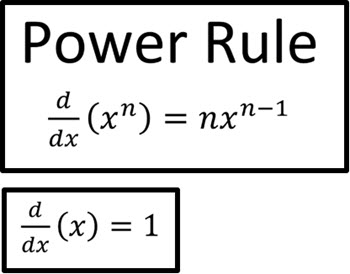Andymath.com features free videos, notes, and practice problems with answers! Printable pages make math easy. Are you ready to be a mathmagician?
Notes

Questions
Find the derivative
\(\textbf{1)}\) \(f(x)=\displaystyle\frac{1}{x^4}\) 
\(\textbf{2)}\) \(f(x)=x^5\)
\(\textbf{3)}\) \(f(x)=x\)
\(\textbf{4)}\) \(f(x)=\displaystyle\frac{3}{x}\)
\(\textbf{5)}\) \(f(x)=\displaystyle\frac{1}{x}\)
\(\textbf{6)}\) \(f(x)=3x^4-2x+8\)
\(\textbf{7)}\) \(f(x)=\displaystyle\frac{1}{6}x^3\)
\(\textbf{8)}\) \(f(x)=2^{30}\)
\(\textbf{9)}\) \(f(x)=x^{30}\)
\(\textbf{10)}\) \(f(x)=5\sqrt{x^5}+\frac{10}{x}-x^{300}\)
See Related Pages\(\)
\(\bullet\text{Derivative Calculator }\)
\(\,\,\,\,\,\,\,\,\text{(Symbolab.com)}\)
\(\bullet\text{ Calculus Homepage}\)
\(\,\,\,\,\,\,\,\,\text{All the Best Topics…}\)
\(\bullet\text{ Definition of Derivative}\)
\(\,\,\,\,\,\,\,\, \displaystyle \lim_{\Delta x\to 0} \frac{f(x+ \Delta x)-f(x)}{\Delta x} \)
\(\bullet\text{ Equation of the Tangent Line}\)
\(\,\,\,\,\,\,\,\,f(x)=x^3+3x^2−x \text{ at the point } (2,18)\)
\(\bullet\text{ Derivatives- Constant Rule}\)
\(\,\,\,\,\,\,\,\,\displaystyle\frac{d}{dx}(c)=0\)
\(\bullet\text{ Derivatives- Power Rule}\)
\(\,\,\,\,\,\,\,\,\displaystyle\frac{d}{dx}(x^n)=nx^{n-1}\)
\(\bullet\text{ Derivatives- Constant Multiple Rule}\)
\(\,\,\,\,\,\,\,\,\displaystyle\frac{d}{dx}(cf(x))=cf'(x)\)
\(\bullet\text{ Derivatives- Sum and Difference Rules}\)
\(\,\,\,\,\,\,\,\,\displaystyle\frac{d}{dx}[f(x) \pm g(x)]=f'(x) \pm g'(x)\)
\(\bullet\text{ Derivatives- Sin and Cos}\)
\(\,\,\,\,\,\,\,\,\displaystyle\frac{d}{dx}sin(x)=cos(x)\)
\(\bullet\text{ Derivatives- Product Rule}\)
\(\,\,\,\,\,\,\,\,\displaystyle\frac{d}{dx}[f(x) \cdot g(x)]=f(x) \cdot g'(x)+f'(x) \cdot g(x)\)
\(\bullet\text{ Derivatives- Quotient Rule}\)
\(\,\,\,\,\,\,\,\,\displaystyle\frac{d}{dx}\left[\displaystyle\frac{f(x)}{g(x)}\right]=\displaystyle\frac{g(x) \cdot f'(x)-f(x) \cdot g'(x)}{[g(x)]^2}\)
\(\bullet\text{ Derivatives- Chain Rule}\)
\(\,\,\,\,\,\,\,\,\displaystyle\frac{d}{dx}[f(g(x))]= f'(g(x)) \cdot g'(x)\)
\(\bullet\text{ Derivatives- ln(x)}\)
\(\,\,\,\,\,\,\,\,\displaystyle\frac{d}{dx}[ln(x)]= \displaystyle \frac{1}{x}\)
\(\bullet\text{ Implicit Differentiation}\)
\(\,\,\,\,\,\,\,\,\)
\(\bullet\text{ Horizontal Tangent Line}\)
\(\,\,\,\,\,\,\,\,\)
\(\bullet\text{ Mean Value Theorem}\)
\(\,\,\,\,\,\,\,\,\)
\(\bullet\text{ Related Rates}\)
\(\,\,\,\,\,\,\,\,\)
\(\bullet\text{ Increasing and Decreasing Intervals}\)
\(\,\,\,\,\,\,\,\,\)
\(\bullet\text{ Intervals of concave up and down}\)
\(\,\,\,\,\,\,\,\,\)
\(\bullet\text{ Inflection Points}\)
\(\,\,\,\,\,\,\,\,\)
\(\bullet\text{ Graph of f(x), f'(x) and f”(x)}\)
\(\,\,\,\,\,\,\,\,\)
\(\bullet\text{ Newton’s Method}\)
\(\,\,\,\,\,\,\,\,x_{n+1}=x_n – \displaystyle \frac{f(x_n)}{f'(x_n)}\)
In Summary
The Derivative Power Rule is a fundamental concept in calculus that allows us to calculate the derivative of a function raised to a power.
According to the Derivative Power Rule, the derivative of a function f(x) raised to the power of n is equal to n times the function raised to the power of n-1. The Derivative Power Rule is an important tool for understanding the behavior of functions and their rates of change. It allows us to analyze how a function changes as its input values change, which is useful in a wide range of fields including physics, engineering, and economics. The Derivative Power Rule is typically covered early on in a calculus course. It is a key concept that is introduced early on in the study of derivatives, which is a central topic in calculus.
Math topics that use Derivatives
Optimization: The derivative of a function can be used to find the points at which a function is at a local minimum or maximum. This can be useful for solving optimization problems, where the goal is to find the inputs that will result in the maximum or minimum output.
Rates of Change: The derivative of a function represents the rate of change of the function at a particular point. This can be used to find the rate at which quantities are changing, such as the rate at which a car is accelerating or the rate at which a population is growing.
Graph Sketching: The derivative of a function can be used to sketch the graph of the function. For example, if the derivative is positive at a particular point, then the function is increasing at that point. If the derivative is negative, then the function is decreasing.
Taylor Series: A Taylor series is an infinite series that is used to approximate functions. The derivative of a function is used to find the terms in the Taylor series expansion.
Differential Equations: A differential equation is an equation that involves a function and one or more of its derivatives. The derivative power rule can be used to solve differential equations, by finding the derivative of the function and substituting it into the differential equation.
About Andymath.com
Andymath.com is a free math website with the mission of helping students, teachers and tutors find helpful notes, useful sample problems with answers including step by step solutions, and other related materials to supplement classroom learning. If you have any requests for additional content, please contact Andy at tutoring@andymath.com. He will promptly add the content.
Topics cover Elementary Math, Middle School, Algebra, Geometry, Algebra 2/Pre-calculus/Trig, Calculus and Probability/Statistics. In the future, I hope to add Physics and Linear Algebra content.
Visit me on Youtube, Tiktok, Instagram and Facebook. Andymath content has a unique approach to presenting mathematics. The clear explanations, strong visuals mixed with dry humor regularly get millions of views. We are open to collaborations of all types, please contact Andy at tutoring@andymath.com for all enquiries. To offer financial support, visit my Patreon page. Let’s help students understand the math way of thinking!
Thank you for visiting. How exciting!